2017 NISSAN ALTIMA SEDAN door lock
[x] Cancel search: door lockPage 307 of 497
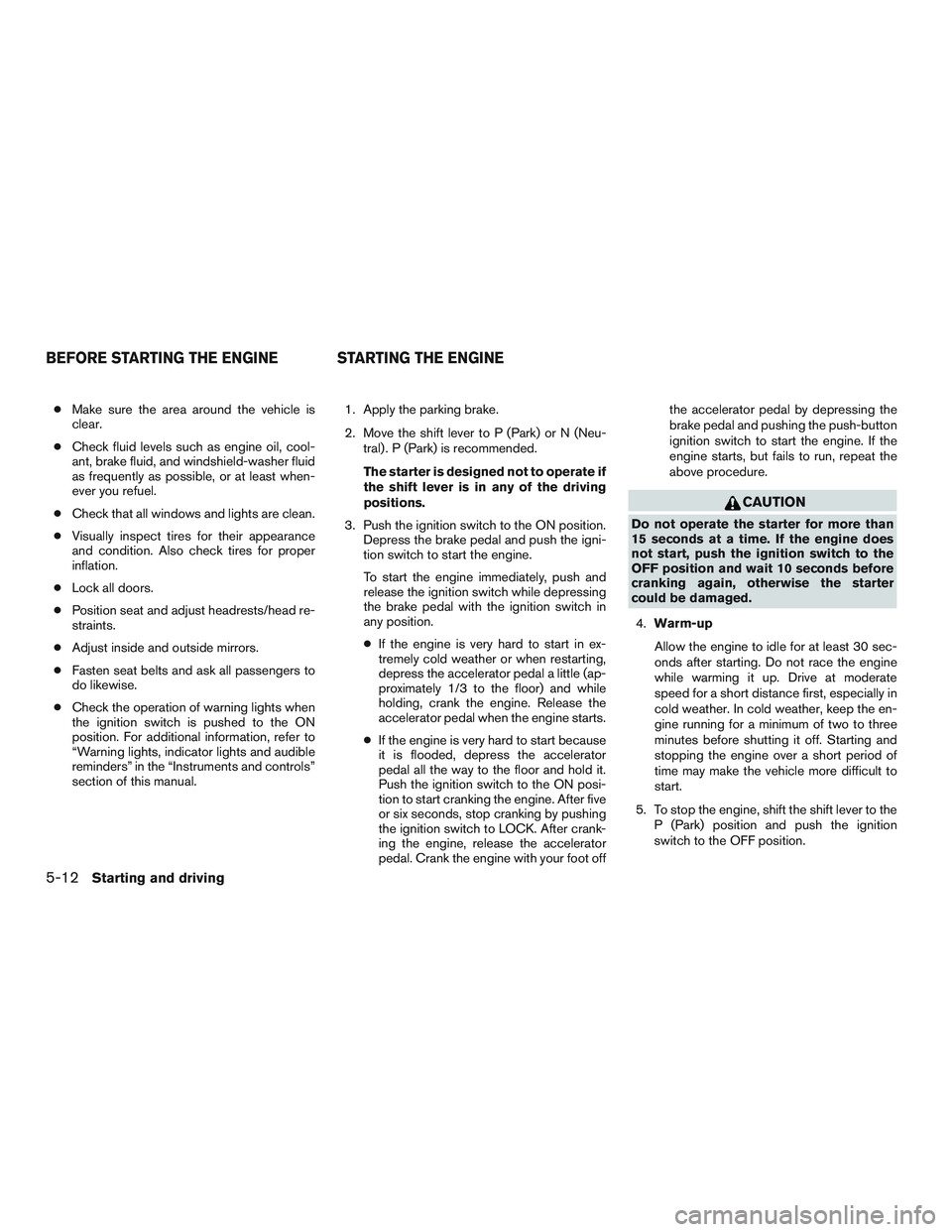
●Make sure the area around the vehicle is
clear.
● Check fluid levels such as engine oil, cool-
ant, brake fluid, and windshield-washer fluid
as frequently as possible, or at least when-
ever you refuel.
● Check that all windows and lights are clean.
● Visually inspect tires for their appearance
and condition. Also check tires for proper
inflation.
● Lock all doors.
● Position seat and adjust headrests/head re-
straints.
● Adjust inside and outside mirrors.
● Fasten seat belts and ask all passengers to
do likewise.
● Check the operation of warning lights when
the ignition switch is pushed to the ON
position. For additional information, refer to
“Warning lights, indicator lights and audible
reminders” in the “Instruments and controls”
section of this manual. 1. Apply the parking brake.
2. Move the shift lever to P (Park) or N (Neu-
tral) . P (Park) is recommended.
The starter is designed not to operate if
the shift lever is in any of the driving
positions.
3. Push the ignition switch to the ON position. Depress the brake pedal and push the igni-
tion switch to start the engine.
To start the engine immediately, push and
release the ignition switch while depressing
the brake pedal with the ignition switch in
any position.
● If the engine is very hard to start in ex-
tremely cold weather or when restarting,
depress the accelerator pedal a little (ap-
proximately 1/3 to the floor) and while
holding, crank the engine. Release the
accelerator pedal when the engine starts.
● If the engine is very hard to start because
it is flooded, depress the accelerator
pedal all the way to the floor and hold it.
Push the ignition switch to the ON posi-
tion to start cranking the engine. After five
or six seconds, stop cranking by pushing
the ignition switch to LOCK. After crank-
ing the engine, release the accelerator
pedal. Crank the engine with your foot off the accelerator pedal by depressing the
brake pedal and pushing the push-button
ignition switch to start the engine. If the
engine starts, but fails to run, repeat the
above procedure.
CAUTION
Do not operate the starter for more than
15 seconds at a time. If the engine does
not start, push the ignition switch to the
OFF position and wait 10 seconds before
cranking again, otherwise the starter
could be damaged.
4. Warm-up
Allow the engine to idle for at least 30 sec-
onds after starting. Do not race the engine
while warming it up. Drive at moderate
speed for a short distance first, especially in
cold weather. In cold weather, keep the en-
gine running for a minimum of two to three
minutes before shutting it off. Starting and
stopping the engine over a short period of
time may make the vehicle more difficult to
start.
5. To stop the engine, shift the shift lever to the P (Park) position and push the ignition
switch to the OFF position.
BEFORE STARTING THE ENGINE STARTING THE ENGINE
5-12Starting and driving
Page 382 of 497
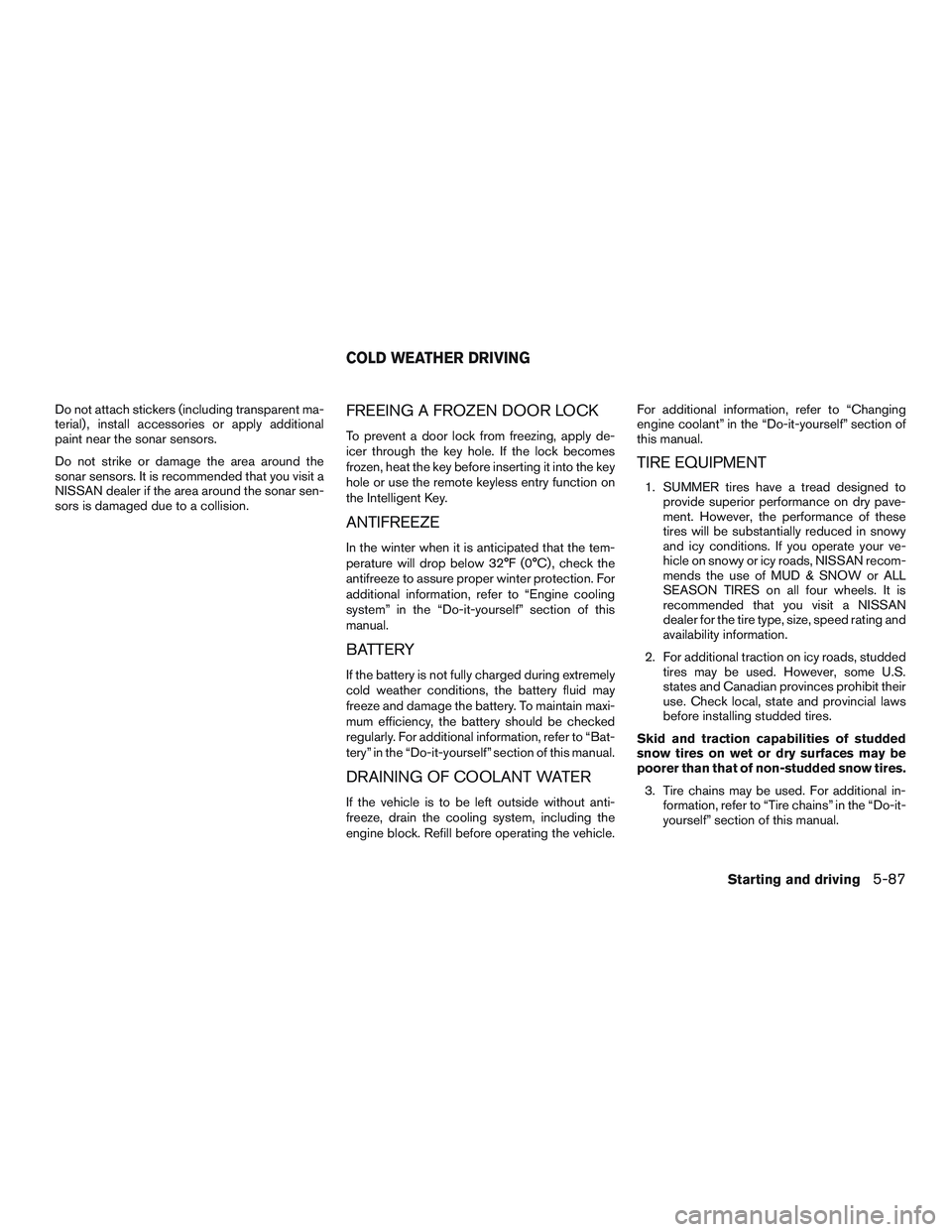
Do not attach stickers (including transparent ma-
terial) , install accessories or apply additional
paint near the sonar sensors.
Do not strike or damage the area around the
sonar sensors. It is recommended that you visit a
NISSAN dealer if the area around the sonar sen-
sors is damaged due to a collision.FREEING A FROZEN DOOR LOCK
To prevent a door lock from freezing, apply de-
icer through the key hole. If the lock becomes
frozen, heat the key before inserting it into the key
hole or use the remote keyless entry function on
the Intelligent Key.
ANTIFREEZE
In the winter when it is anticipated that the tem-
perature will drop below 32°F (0°C) , check the
antifreeze to assure proper winter protection. For
additional information, refer to “Engine cooling
system” in the “Do-it-yourself” section of this
manual.
BATTERY
If the battery is not fully charged during extremely
cold weather conditions, the battery fluid may
freeze and damage the battery. To maintain maxi-
mum efficiency, the battery should be checked
regularly. For additional information, refer to “Bat-
tery” in the “Do-it-yourself” section of this manual.
DRAINING OF COOLANT WATER
If the vehicle is to be left outside without anti-
freeze, drain the cooling system, including the
engine block. Refill before operating the vehicle.For additional information, refer to “Changing
engine coolant” in the “Do-it-yourself” section of
this manual.
TIRE EQUIPMENT
1. SUMMER tires have a tread designed to
provide superior performance on dry pave-
ment. However, the performance of these
tires will be substantially reduced in snowy
and icy conditions. If you operate your ve-
hicle on snowy or icy roads, NISSAN recom-
mends the use of MUD & SNOW or ALL
SEASON TIRES on all four wheels. It is
recommended that you visit a NISSAN
dealer for the tire type, size, speed rating and
availability information.
2. For additional traction on icy roads, studded tires may be used. However, some U.S.
states and Canadian provinces prohibit their
use. Check local, state and provincial laws
before installing studded tires.
Skid and traction capabilities of studded
snow tires on wet or dry surfaces may be
poorer than that of non-studded snow tires. 3. Tire chains may be used. For additional in- formation, refer to “Tire chains” in the “Do-it-
yourself” section of this manual.
COLD WEATHER DRIVING
Starting and driving5-87
Page 451 of 497
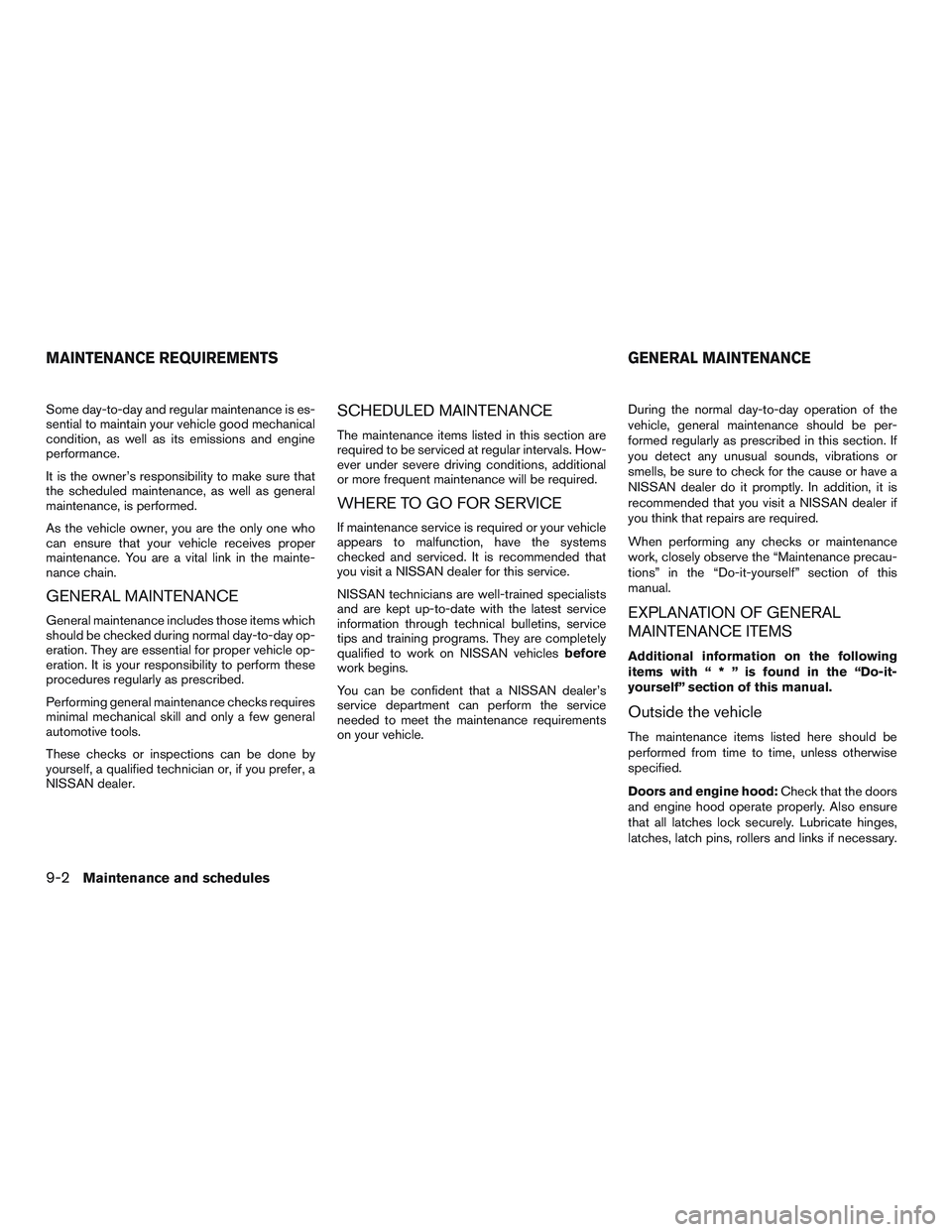
Some day-to-day and regular maintenance is es-
sential to maintain your vehicle good mechanical
condition, as well as its emissions and engine
performance.
It is the owner’s responsibility to make sure that
the scheduled maintenance, as well as general
maintenance, is performed.
As the vehicle owner, you are the only one who
can ensure that your vehicle receives proper
maintenance. You are a vital link in the mainte-
nance chain.
GENERAL MAINTENANCE
General maintenance includes those items which
should be checked during normal day-to-day op-
eration. They are essential for proper vehicle op-
eration. It is your responsibility to perform these
procedures regularly as prescribed.
Performing general maintenance checks requires
minimal mechanical skill and only a few general
automotive tools.
These checks or inspections can be done by
yourself, a qualified technician or, if you prefer, a
NISSAN dealer.
SCHEDULED MAINTENANCE
The maintenance items listed in this section are
required to be serviced at regular intervals. How-
ever under severe driving conditions, additional
or more frequent maintenance will be required.
WHERE TO GO FOR SERVICE
If maintenance service is required or your vehicle
appears to malfunction, have the systems
checked and serviced. It is recommended that
you visit a NISSAN dealer for this service.
NISSAN technicians are well-trained specialists
and are kept up-to-date with the latest service
information through technical bulletins, service
tips and training programs. They are completely
qualified to work on NISSAN vehiclesbefore
work begins.
You can be confident that a NISSAN dealer’s
service department can perform the service
needed to meet the maintenance requirements
on your vehicle. During the normal day-to-day operation of the
vehicle, general maintenance should be per-
formed regularly as prescribed in this section. If
you detect any unusual sounds, vibrations or
smells, be sure to check for the cause or have a
NISSAN dealer do it promptly. In addition, it is
recommended that you visit a NISSAN dealer if
you think that repairs are required.
When performing any checks or maintenance
work, closely observe the “Maintenance precau-
tions” in the “Do-it-yourself” section of this
manual.
EXPLANATION OF GENERAL
MAINTENANCE ITEMS
Additional information on the following
items with“*”isfound in the “Do-it-
yourself” section of this manual.
Outside the vehicle
The maintenance items listed here should be
performed from time to time, unless otherwise
specified.
Doors and engine hood:
Check that the doors
and engine hood operate properly. Also ensure
that all latches lock securely. Lubricate hinges,
latches, latch pins, rollers and links if necessary.
MAINTENANCE REQUIREMENTS GENERAL MAINTENANCE
9-2Maintenance and schedules
Page 488 of 497
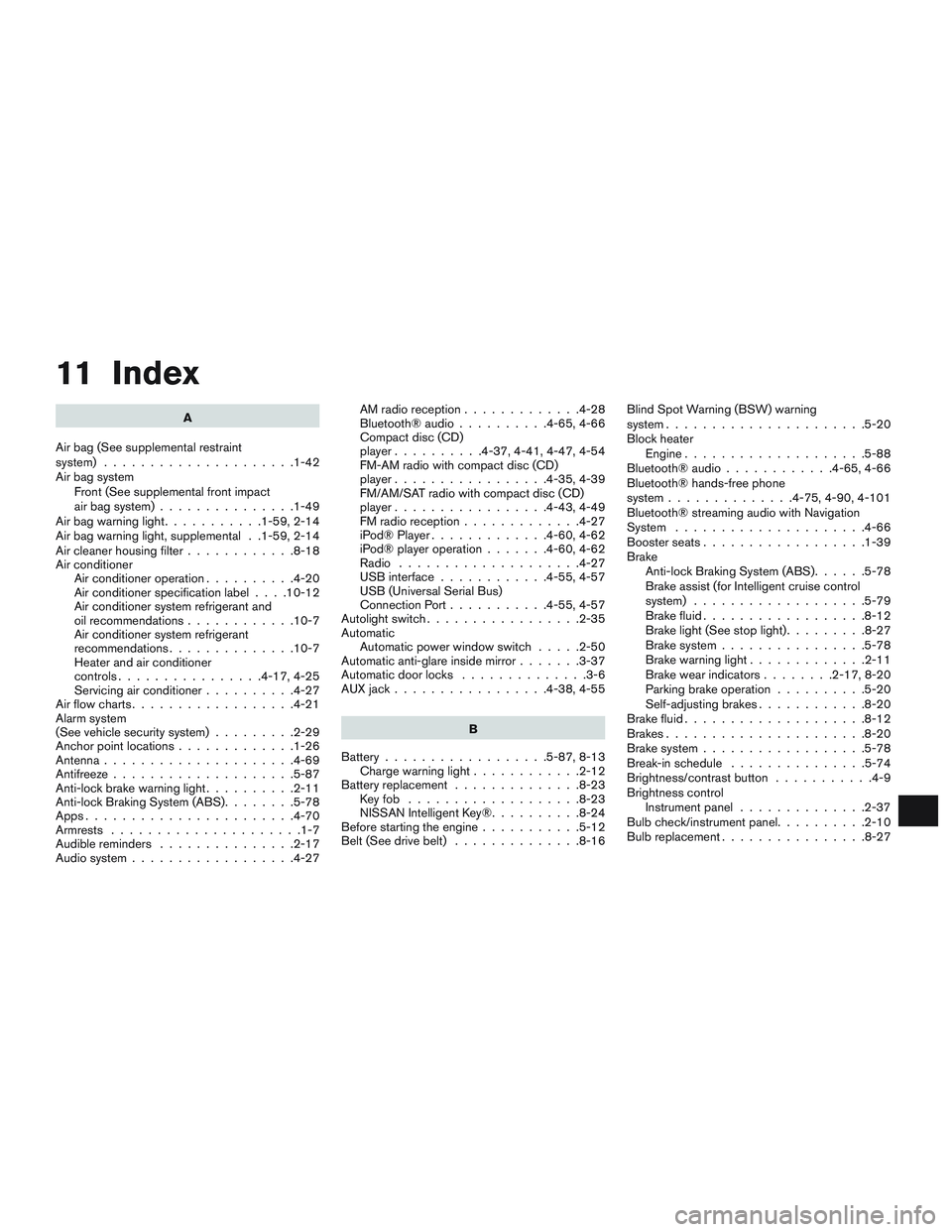
11 Index
A
Air bag (See supplemental restraint
system) .....................1-42
Air bag system Front (See supplemental front impact
air bag system) ...............1-49
Airbagwarninglight...........1-59,2-14
Air bag warning light, supplemental . .1-59, 2-14
Air cleaner housing filter ............8-18
Air conditioner Air conditioner operation ..........4-20
Air conditioner specification label ....10-12
Air conditioner system refrigerant and
oil recommendations ............10-7
Air conditioner system refrigerant
recommendations ..............10-7
Heater and air conditioner
controls................4-17,4-25
Servicing air conditioner ..........4-27
Airflowcharts..................4-21
Alarm system
(See vehicle security system) .........2-29
Anchor point locations .............1-26
Antenna .....................4-69
Antifreeze ....................5-87
Anti-lock brake warning light ..........2-11
Anti-lock Braking System (ABS) ........5-78
Apps .......................4-70
Armrests .....................1-7
Audible reminders ...............2-17
Audio system ..................4-27 AMradioreception.............4-28
Bluetooth®audio..........4-65,4-66
Compact disc (CD)
player..........4-37,4-41,4-47,4-54
FM-AM radio with compact disc (CD)
player.................4-35,4-39
FM/AM/SAT radio with compact disc (CD)
player.................4-43,4-49
FMradioreception.............4-27
iPod® Player
.............4-60,4-62
iPod® player operation .......4-60,4-62
Radio ....................4-27
USB interface ............4-55,4-57
USB (Universal Serial Bus)
Connection Port ...........4-55,4-57
Autolight switch .................2-35
Automatic Automatic power window switch .....2-50
Automatic anti-glare inside mirror .......3-37
Automatic door locks ..............3-6
AUXjack.................4-38,4-55
B
Battery ..................5-87,8-13
Chargewarninglight............2-12
Battery replacement ..............8-23
Keyfob ...................8-23
NISSAN Intelligent Key® ..........8-24
Before starting the engine ...........5-12
Belt (See drive belt) ..............8-16 Blind Spot Warning (BSW) warning
system......................5-20
Block heater
Engine ....................5-88
Bluetooth® audio ............4-65,4-66
Bluetooth® hands-free phone
system..............4-75,4-90,4-101
Bluetooth® streaming audio with Navigation
System .....................4-66
Boosterseats..................1-39
Brake Anti-lock Braking System (ABS) ......5-78
Brake assist (for Intelligent cruise control
system) ...................5-79
Brake fluid ..................8-12
Brakelight(Seestoplight).........8-27
Brake system ................5-78
Brakewarninglight.............2-11
Brakewearindicators........2-17,8-20
Parking brake operation ..........5-20
Self-adjusting brakes ............8-20
Brake fluid ....................8-12
Brakes ......................8-20
Brake system ..................5-78
Break-inschedule ...............5-74
Brightness/contrast button ...........4-9
Brightness control Instrument panel ..............2-37
Bulb check/instrument panel ..........2-10
Bulbreplacement................8-27
Page 489 of 497
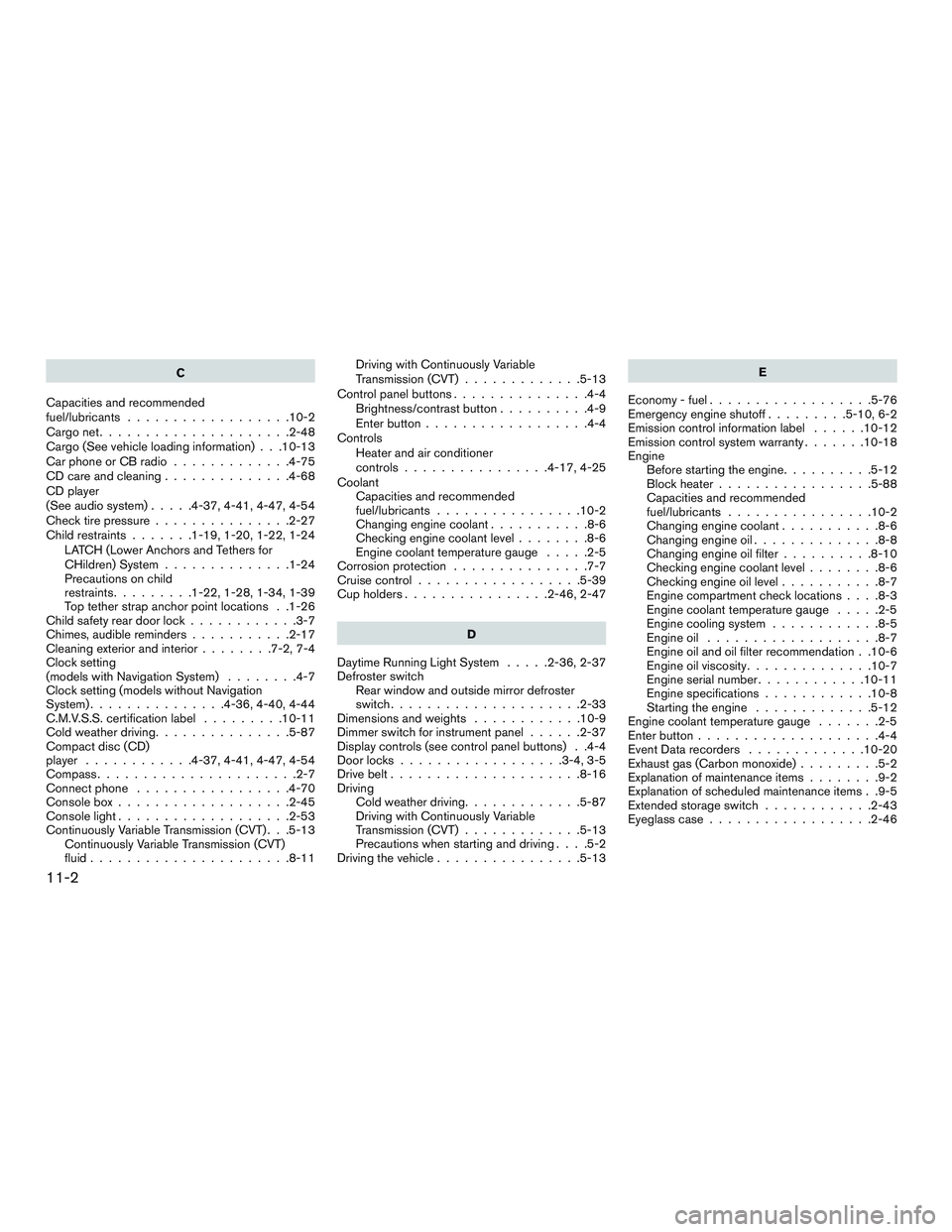
C
Capacities and recommended
fuel/lubricants ..................10-2
Cargonet.....................2-48
Cargo (See vehicle loading information) . . .10-13
Car phone or CB radio .............4-75
CD care and cleaning ..............4-68
CD player
(See audio system) .....4-37,4-41,4-47,4-54
Check tire pressure ...............2-27
Child restraints .......1-19,1-20,1-22,1-24
LATCH (Lower Anchors and Tethers for
CHildren) System ..............1-24
Precautions on child
restraints.........1-22,1-28,1-34,1-39
Top tether strap anchor point locations . .1-26
Child safety rear door lock ............3-7
Chimes, audible reminders ...........2-17
Cleaningexteriorandinterior........7-2,7-4
Clock setting
(models with Navigation System) ........4-7
Clock setting (models without Navigation
System) ...............4-36,4-40,4-44
C.M.V.S.S. certification label .........10-11
Cold weather driving ...............5-87
Compact disc (CD)
player ............4-37,4-41,4-47,4-54
Compass ......................2-7
Connect phone .................4-70
Consolebox...................2-45
Consolelight...................2-53
Continuously Variable Transmission (CVT) . . .5-13 Continuously Variable Transmission (CVT)
fluid ......................8-11 Driving with Continuously Variable
Transmission (CVT)
.............5-13
Control panel buttons ...............4-4
Brightness/contrast button ..........4-9
Enterbutton..................4-4
Controls Heater and air conditioner
controls................4-17,4-25
Coolant Capacities and recommended
fuel/lubricants ................10-2
Changingenginecoolant...........8-6
Checking engine coolant level ........8-6
Engine coolant temperature gauge .....2-5
Corrosion protection ...............7-7
Cruisecontrol..................5-39
Cupholders................2-46,2-47
D
Daytime Running Light System .....2-36,2-37
Defroster switch Rear window and outside mirror defroster
switch.....................2-33
Dimensionsandweights ............10-9
Dimmer switch for instrument panel ......2-37
Display controls (see control panel buttons) . .4-4
Door locks ..................3-4,3-5
Drive belt .....................8-16
Driving Cold weather driving .............5-87
Driving with Continuously Variable
Transmission (CVT) .............5-13
Precautions when starting and driving ....5-2
Driving the vehicle ................5-13 E
Economy-fuel..................5-76
Emergency engine shutoff .........5-10,6-2
Emission control information label ......10-12
Emission control system warranty .......10-18
Engine Before starting the engine ..........5-12
Blockheater.................5-88
Capacities and recommended
fuel/lubricants ................10-2
Changing engine coolant ...........8-6
Changingengineoil..............8-8
Changing engine oil filter ..........8-10
Checking engine coolant level ........8-6
Checking engine oil level ...........8-7
Engine compartment check locations ....8-3
Engine
coolant temperature gauge .....2-5
Engine cooling system ............8-5
Engineoil ...................8-7
Engine oil and oil filter recommendation . .10-6
Engine oil viscosity ..............10-7
Engine serial number ............10-11
Engine specifications ............10-8
Starting the engine .............5-12
Engine coolant temperature gauge .......2-5
Enter button ....................4-4
Event Data recorders .............10-20
Exhaust gas (Carbon monoxide) .........5-2
Explanation of maintenance items ........9-2
Explanation of scheduled maintenance items . .9-5
Extended storage switch ............2-43
Eyeglass case ..................2-46
11-2
Page 490 of 497
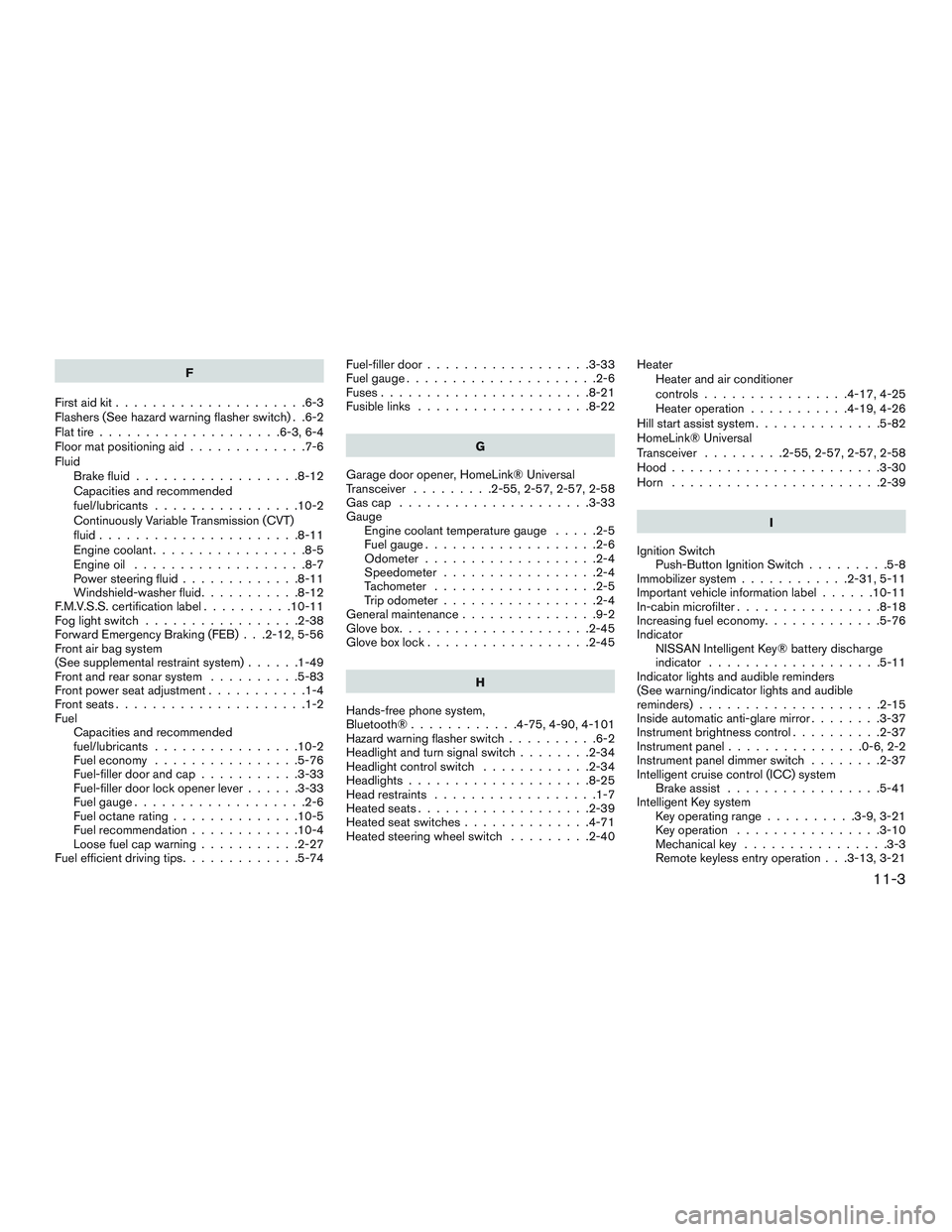
F
First aid kit .....................6-3
Flashers (See hazard warning flasher switch) . .6-2
Flat tire ....................6-3,6-4
Floor mat positioning aid .............7-6
Fluid Brake fluid ..................8-12
Capacities and recommended
fuel/lubricants ................10-2
Continuously Variable Transmission (CVT)
fluid......................8-11
Engine coolant .................8-5
Engine oil ...................8-7
Power steering fluid .............8-11
Windshield-washerfluid...........8-12
F.M.V.S.S. certification label ..........10-11
Foglightswitch .................2-38
Forward Emergency Braking (FEB) . . .2-12, 5-56
Front air bag system
(See supplemental restraint system) ......1-49
Front and rear sonar system ..........5-83
Front power seat adjustment ...........1-4
Frontseats.....................1-2
Fuel Capacities and recommended
fuel/lubricants ................10-2
Fuel economy ................5-76
Fuel-filler door and cap ...........3-33
Fuel-filler door lock opener lever ......3-33
Fuel gauge ...................2-6
Fuel octane rating ..............10-5
Fuel recommendation ............10-4
Loose fuel cap warning ...........2-27
Fuel efficient driving tips .............5-74 Fuel-filler door
..................3-33
Fuelgauge.....................2-6
Fuses.......................8-21
Fusiblelinks ...................8-22
G
Garage door opener, HomeLink® Universal
Transceiver .........2-55,2-57,2-57,2-58
Gascap .....................3-33
Gauge Engine coolant temperature gauge .....2-5
Fuel gauge ...................2-6
Odometer ...................2-4
Speedometer .................2-4
Tachometer ..................2-5
Trip odometer .................2-4
General maintenance ...............9-2
Glovebox.....................2-45
Gloveboxlock..................2-45
H
Hands-free phone system,
Bluetooth®............4-75,4-90,4-101
Hazard warning flasher switch ..........6-2
Headlight and turn signal switch ........2-34
Headlight control switch ............2-34
Headlights ....................8-25
Head restraints ..................1-7
Heated seats ...................2-39
Heated seat switches ..............4-71
Heated steering wheel switch .........2-40Heater
Heater and air conditioner
controls ................4-17,4-25
Heater operation ...........4-19,4-26
Hill start assist system ..............5-82
HomeLink® Universal
Transceiver .........2-55,2-57,2-57,2-58
Hood.......................3-30
Horn .......................2-39
I
Ignition Switch Push-Button Ignition Switch .........5-8
Immobilizer system ............2-31,5-11
Important vehicle information label ......
10-11
In-cabin microfilter ................8-18
Increasing fuel economy .............5-76
Indicator NISSAN Intelligent Key® battery discharge
indicator ...................5-11
Indicator lights and audible reminders
(See warning/indicator lights and audible
reminders)....................2-15
Inside automatic anti-glare mirror ........3-37
Instrument brightness control ..........2-37
Instrumentpanel...............0-6,2-2
Instrument panel dimmer switch ........2-37
Intelligent cruise control (ICC) system Brake assist .................5-41
Intelligent Key system Key operating range ..........3-9,3-21
Key operation ................3-10
Mechanical key ................3-3
Remote keyless entry operation . . .3-13, 3-21
11-3
Page 491 of 497
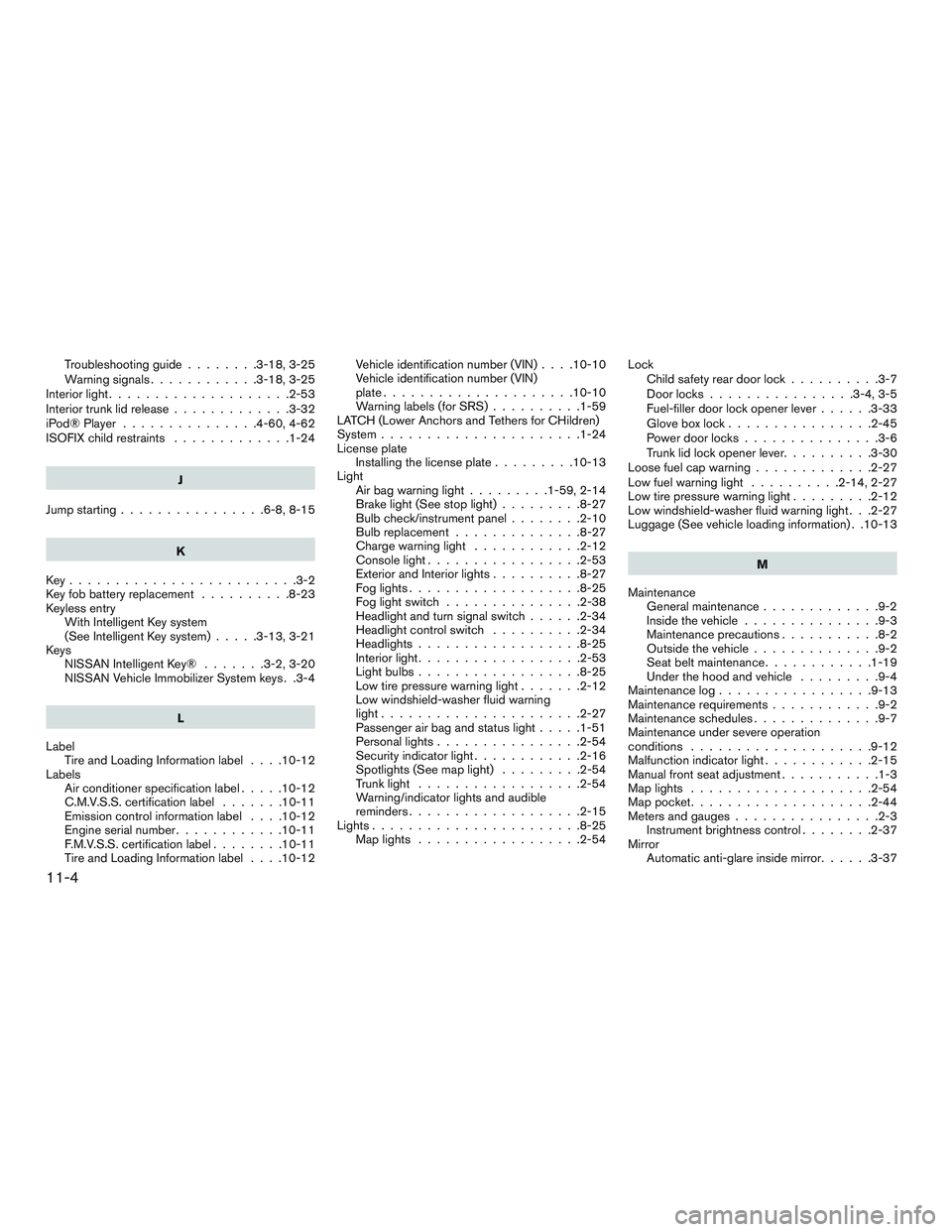
Troubleshooting guide........3-18,3-25
Warning signals ............3-18,3-25
Interiorlight....................2-53
Interiortrunklidrelease.............3-32
iPod®Player ...............4-60,4-62
ISOFIX child restraints .............1-24
J
Jump starting ................6-8,8-15
K
Key.........................3-2
Key fob battery replacement ..........8-23
Keyless entry With Intelligent Key system
(See Intelligent Key system) .....3-13,3-21
Keys NISSAN Intelligent Key® .......3-2,3-20
NISSAN Vehicle Immobilizer System keys . .3-4
L
Label Tire and Loading Information label ....10-12
Labels Air conditioner specification label .....10-12
C.M.V.S.S. certification label .......10-11
Emissioncontrolinformationlabel ....10-12
Engine serial number ............10-11
F.M.V.S.S. certification label ........10-11
Tire and Loading Information label ....10-12Vehicle identification number (VIN)
....10-10
Vehicle identification number (VIN)
plate.....................10-10
Warning labels (for SRS) ..........1-59
LATCH (Lower Anchors and Tethers for CHildren)
System ......................1-24
License plate Installing the license plate .........10-13
Light Air bag warning light .........1-59,2-14
Brake light (See stop light) .........8-27
Bulb check/instrument panel ........2-10
Bulbreplacement..............8-27
Charge warning light ............2-12
Consolelight.................2-53
Exterior and Interior lights ..........8-27
Foglights...................8-25
Foglightswitch ...............2-38
Headlight and turn signal switch ......2-34
Headlight control switch ..........2-34
Headlights..................8-25
Interiorlight..................2-53
Lightbulbs..................8-25
Low tire pressure warning light .......2-12
Low windshield-washer fluid warning
light......................2-27
Passenger air bag and status light .....1-51
Personal lights ................2-54
Security indicator light ............2-16
Spotlights(Seemaplight) .........2-54
Trunklight ..................2-54
Warning/indicator lights and audible
reminders ...................2-15
Lights.......................8-25 Maplights ..................2-54 Lock
Child safety rear door lock ..........3-7
Door locks ................3-4,3-5
Fuel-filler door lock opener lever ......3-33
Gloveboxlock................2-45
Power door locks ...............3-6
Trunk lid lock opener lever ..........3-30
Loose fuel cap warning .............2-27
Low fuel warning light ..........2-14,2-27
Low tire pressure warning light .........2-12
Low windshield-washer fluid warning light . . .2-27
Luggage (See vehicle loading information) . .10-13
M
Maintenance General maintenance .............9-2
Insidethevehicle...............9-3
Maintenance precautions ...........8-2
Outside the vehicle ..............9-2
Seat belt maintenance ............1-19
Under the hood and vehicle .........
9-4
Maintenancelog.................9-13
Maintenance requirements ............9-2
Maintenance schedules ..............9-7
Maintenance under severe operation
conditions ....................9-12
Malfunction indicator light ............2-15
Manual front seat adjustment ...........1-3
Maplights ....................2-54
Mappocket....................2-44
Meters and gauges ................2-3
Instrument brightness control ........2-37
Mirror Automatic anti-glare inside mirror ......3-37
11-4
Page 492 of 497
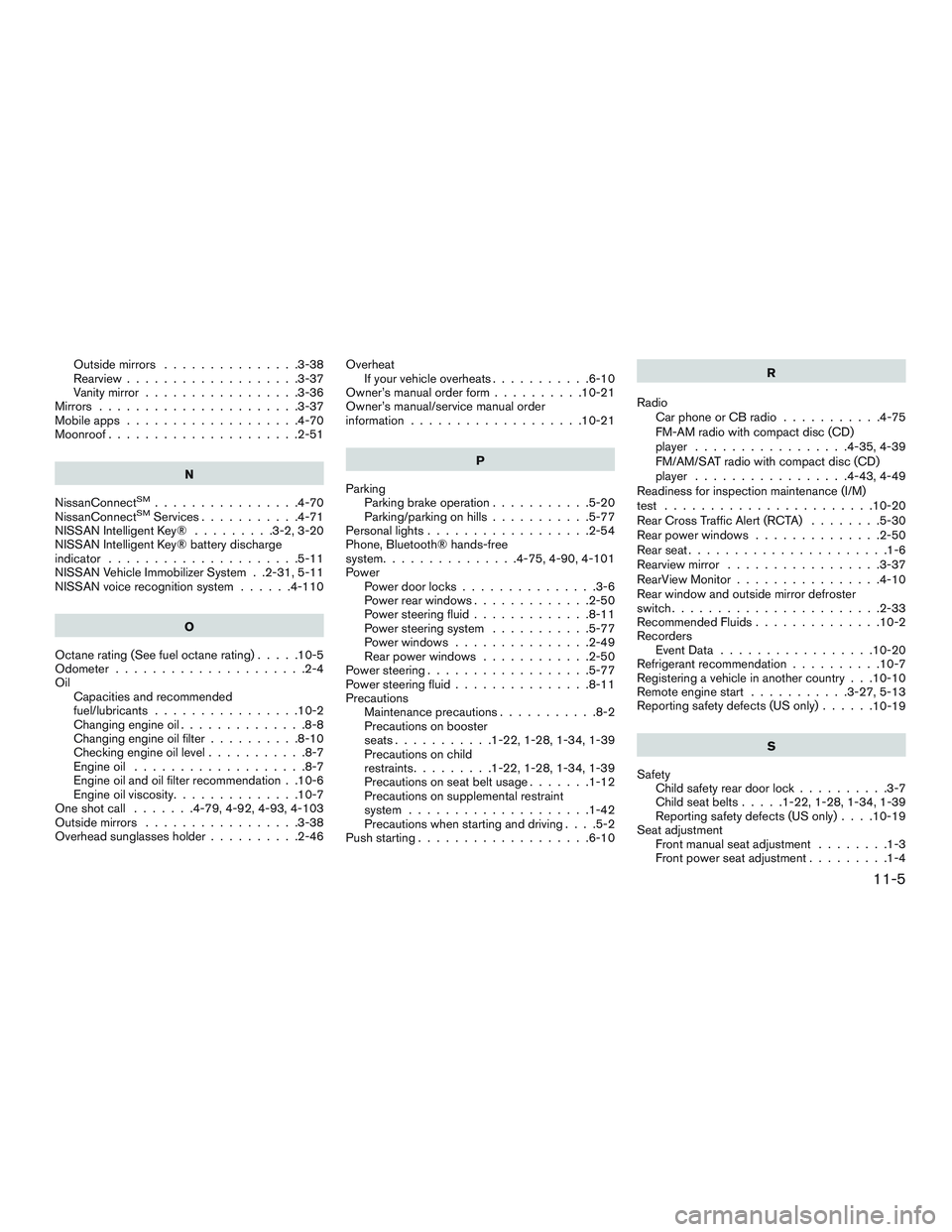
Outside mirrors...............3-38
Rearview ...................3-37
Vanity mirror .................3-36
Mirrors ......................3-37
Mobileapps ...................4-70
Moonroof .....................2-51
N
NissanConnect
SM................4-70
NissanConnectSMServices...........4-71
NISSAN Intelligent Key® .........3-2,3-20
NISSAN Intelligent Key® battery discharge
indicator .....................5-11
NISSAN Vehicle Immobilizer System . .2-31, 5-11
NISSAN voice recognition system ......4-110
O
Octanerating(Seefueloctanerating).....10-5
Odometer .....................2-4
Oil Capacities and recommended
fuel/lubricants ................10-2
Changing engine oil ..............8-8
Changing engine oil filter ..........8-10
Checking engine oil level ...........8-7
Engine oil ...................8-7
Engine oil and oil filter recommendation . .10-6
Engine oil viscosity ..............10-7
Oneshotcall .......4-79,4-92,4-93,4-103
Outside mirrors .................3-38
Overhead sunglasses holder ..........2-46Overheat
If your vehicle overheats ...........6-10
Owner’s manual order form ..........10-21
Owner’s manual/service manual order
information ...................10-21
P
Parking Parking brake operation ...........5-20
Parking/parking on hills ...........5-77
Personallights..................2-54
Phone, Bluetooth® hands-free
system ...............4-75,4-90,4-101
Power Power door locks ...............3-6
Power rear windows .............2-50
Power steering fluid .............8-11
Power steering system ...........5-77
Power windows ...............2-49
Rear power windows ............2-50
Power steering ..................5-77
Power steering fluid ...............8-11
Precautions Maintenance precautions ...........8-2
Precautions on booster
seats...........1-22,1-28,1-34,1-39
Precautions on child
restraints .........1-22,1-28,1-34,1-39
Precautions on seat belt usage .......1-12
Precautions on supplemental restraint
system ....................1-42
Precautions when starting and driving ....5-2
Push starting ...................6-10 R
Radio CarphoneorCBradio ...........4-75
FM-AM radio with compact disc (CD)
player .................4-35,4-39
FM/AM/SAT radio with compact disc (CD)
player .................4-43,4-49
Readiness for inspection maintenance (I/M)
test .......................10-20
Rear Cross Traffic Alert (RCTA) ........5-30
Rear power windows ..............2-50
Rearseat......................1-6
Rearview mirror .................3-37
RearView Monitor ................4-10
Rear window and outside mirror defroster
switch.......................2-33
Recommended Fluids ..............10-2
Recorders EventData .................10-20
Refrigerant recommendation ..........10-7
Registering a vehicle in another country . . .10-10
Remote engine start ...........3-27,5-13
Reporting safety defects (US only) ......
10-19
S
Safety Child safety rear door lock ..........3-7
Child seat belts .....1-22,1-28,1-34,1-39
Reporting safety defects (US only) ....10-19
Seat adjustment Front manual seat adjustment ........1-3
Front power seat adjustment .........1-4
11-5